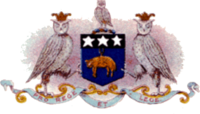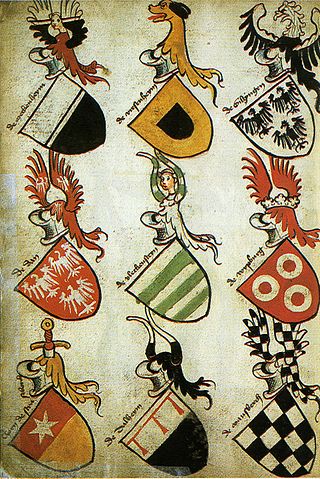
Heraldry is a discipline relating to the design, display and study of armorial bearings, as well as related disciplines, such as vexillology, together with the study of ceremony, rank and pedigree. Armory, the best-known branch of heraldry, concerns the design and transmission of the heraldic achievement. The achievement, or armorial bearings usually includes a coat of arms on a shield, helmet and crest, together with any accompanying devices, such as supporters, badges, heraldic banners and mottoes.
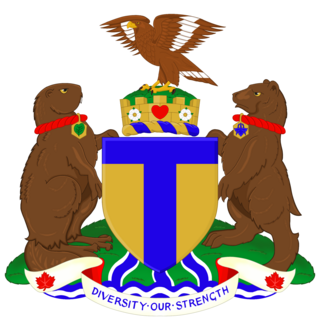
The coat of arms of Toronto is a heraldic symbol used to represent the city Toronto. Designed by Robert Watt, the Chief Herald of Canada at the time, for the City of Toronto after its amalgamation in 1998. The arms were granted by the Canadian Heraldic Authority on 11 January 1999.

The coat of arms of Sunderland is the official heraldic arms of the City of Sunderland in England.

The coat of arms of New South Wales is the official coat of arms of the Australian state of New South Wales. It was granted by royal warrant of King Edward VII dated 11 October 1906.

Portuguese heraldry encompasses the modern and historic traditions of heraldry in Portugal and the Portuguese Empire. Portuguese heraldry is part of the larger Iberian tradition of heraldry, one of the major schools of heraldic tradition, and grants coats of arms to individuals, cities, Portuguese colonies, and other institutions. Heraldry has been practiced in Portugal at least since the 12th century, however it only became standardized and popularized in the 16th century, during the reign of King Manuel I of Portugal, who created the first heraldic ordinances in the country. Like in other Iberian heraldic traditions, the use of quartering and augmentations of honor is highly representative of Portuguese heraldry, but unlike in any other Iberian traditions, the use of heraldic crests is highly popular.

The coat of arms of Cape Town is the traditional symbol of the municipality of Cape Town. The original arms from the 20th century are no longer in official use, though no new arms have yet been adopted.

The London County Council was granted a coat of arms in 1914 and a heraldic badge in 1956. The coat of arms can still be seen on buildings constructed by the council before its abolition in 1965.

The coat of arms of Bradford was granted in 1976. The present City of Bradford was created in 1974 by the Local Government Act 1972 and is one of five metropolitan boroughs of West Yorkshire. The 1976 arms are based on those of its predecessor, the County Borough of Bradford.
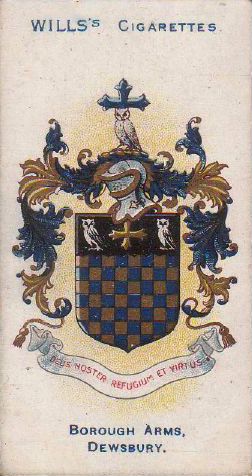
The coat of arms of Dewsbury was the official symbol of the county borough of Dewsbury in the West Riding of Yorkshire. The county borough was abolished in 1974 under the provisions of the Local Government Act 1972 and replaced by Kirklees Metropolitan Council and West Yorkshire Metropolitan County Council.

The coat of arms of Wigan Metropolitan Borough Council was granted by the College of Arms in 1974.

The coat of arms of the City of Christchurch, also known as the armorial bearings, is the official symbol of the City of Christchurch, New Zealand. They were granted to the city by the College of Arms by letters patent on 21 February 1949.

The coat of arms of Newport is the heraldic emblem of the city of Newport, South Wales. Also known as the Civic Badge, it has been borne by the present Newport City Council since 24 July 1996 following the municipal reorganisation in April that year.
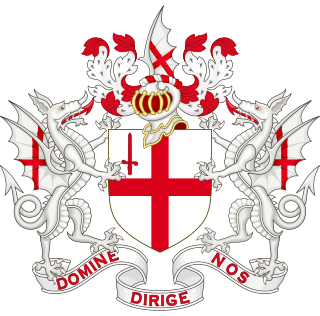
The coat of arms of the City of London is the official coat of arms of the City of London, England, which is one of a number of cities and boroughs in Greater London.
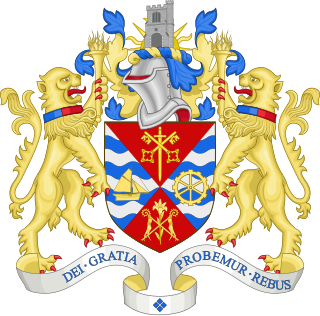
The coat of arms of the London Borough of Barking and Dagenham was granted on 1 September 1965. It is based on the arms of Barking Borough Council and Dagenham Borough Council, the predecessors of the current local authority. The various elements represent the borough; the crest, for example, includes the surviving tower of Barking Abbey.

Coat of arms of the London Borough of Bexley is the official coat of arms of the London Borough of Bexley, granted on 20 May 1965.

The coat of arms of the London Borough of Camden were granted on 10 September 1965. The borough was formed by the merger of three former boroughs, namely the Metropolitan Borough of Hampstead, the Metropolitan Borough of Holborn and the Metropolitan Borough of St. Pancras, from whose arms elements were utilised in the arms of the new borough.
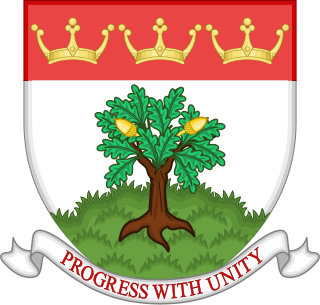
The coat of arms of the London Borough of Ealing is the official heraldic arms of the London Borough of Ealing, England, granted on 1 September 1965.

The coat of arms of the London Borough of Hackney is the official heraldic arms of the London Borough of Hackney, England. The coat of arms were granted on 25 July 1969.

The coat of arms of Oxford is the official heraldic arms of Oxford, England, used by Oxford City Council.
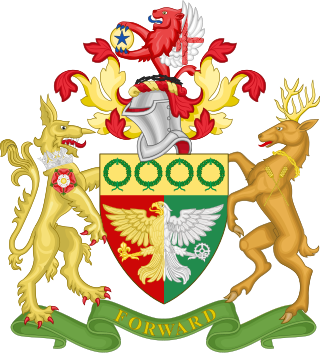
The coat of arms of the London Borough of Hillingdon is the official symbol of the London Borough of Hillingdon. They use elements from the coats of arms of the four previous districts. It is described as:
Arms: Per pale Gules and Vert an Eagle displayed per pale Or and Argent in the dexter claw a Fleur-de-lis Or and in the sinister claw a Cog-Wheel Argent on a Chief Or four Civic Crowns Vert.
Crest: On a Wreath of the Colours issuant from a Circlet of Brushwood Sable a demi-Lion Gules with wings Argent the underside of each wing charged with a Cross Gules and holding between the paws a Bezant thereon a Mullet Azure.
Supporters: On the dexter side an Heraldic Tiger Or gorged with an Astral Crown Azure and charged on the shoulder with a Rose Gules charged with another Argent barbed and seeded proper and on the sinister side a Stag proper attired and gorged with a Circlet of Brushwood and charged on the shoulder with two Ears of Rye slipped in saltire Or.
Motto: Forward.

